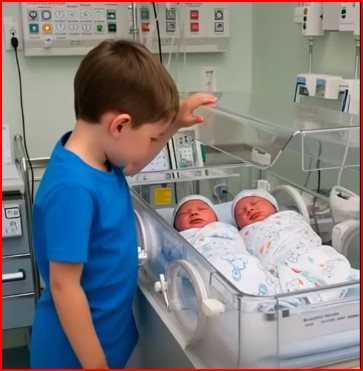They arrived into the world just yesterday — two tiny sisters, still wet with birth and wrapped in hospital blankets. Their lungs found air for the first time, their fingers curled instinctively, and nurses hummed softly as they checked tiny reflexes. Family members whispered, tears of joy and relief were shed, and for a few fragile hours a hospital room held the electric, tender hush of a new beginning.
And then, in the same breath, the unthinkable settled in: their mother would never wake again.
This is a story of life and loss braided together — of celebration cut short, of a mother’s final act of love, and of the enormous weight that falls on a family when grief and responsibility arrive together. Below is a full, compassionate rephrasing and expansion of your text, written to honor the experience, explain the practical realities families face in such situations, and offer comfort and resources for anyone touched by similar tragedy.
A Joyful Beginning — and a Sudden, Quiet Ending
When a child is born, the room usually fills with sound: soft cries, the rustle of linens, the excited chatter of family members. Even in difficult deliveries there can be relief at the first breath. In this case, two daughters entered that world at once — a double miracle that brings a community to attention. Twins or close-in-age siblings carry a special kind of promise: lifelong companionship, shared secrets, and a bond that often feels almost magical.
In the hours after a birth, a mother’s presence is central. She is the one who bore the pregnancy, who labored, who first held both infants skin-to-skin. But sometimes the human body and the complications of childbirth or the underlying medical emergency conspire against us. When a mother dies around the time of delivery, medical staff rush to save both the newborns and the parent, but not every outcome can be controlled. The result is a bitter mixture of miracle and mourning: two tiny lives begin without the person who gave them life.
That paradox — the newborns’ first breaths and a parent’s last — is almost impossible to hold emotionally. It leaves family, friends, and the wider community in stunned, raw shock.
Holding Two Truths at Once: Joy and Grief
It’s worth pausing to name the complexity of this moment. People often expect grief to be a single feeling, a steady, understandable river that flows from loss. In reality, grief and gratitude, sorrow and awe, can exist together in ways that are confusing and intense.
- The family sees the newborns and feels overwhelming love and a surge of protectiveness.
- At the same time, every motion of those infants — their tiny hands, the way they nestle into a blanket, the smell of newborn skin — is also a reminder of the person who will not see them grow.
- Friends and community members line up to offer congratulations and condolences in the same conversation, fumbling for words that honor both realities.
This is not a contradiction to be resolved immediately. It’s a lived truth: two new lives beginning as one precious life ends.
The Mother’s Final Gift
When people say someone “gave everything,” it’s often an expression of gratitude. In many cases of maternal death at or after childbirth, the phrase becomes literal. A mother’s body undergoes tremendous strain during pregnancy and delivery. When unexpected medical complications occur — hemorrhage, hypertension-related crises, infections, embolisms, or underlying conditions that manifest acutely — interventions can be heroic yet insufficient. Modern medicine has made maternal mortality uncommon in many places, but it still happens, sometimes without warning.
Saying the mother “gave everything” honours the sacrifice of that person’s life, her labor, and the love that carried those pregnancies to their end. It recognizes that children were born into life because a mother’s body did its most essential work — and because other people (doctors, nurses, sometimes family members who made agonizing decisions) acted to protect the infants. That reality shapes the narrative the family will now tell about her: as provider, protector, and person of great courage.
Immediate Practical Steps: What Happens After the Hospital
In the hours and days following such a loss, practical tasks and legal realities become unavoidable. Grief makes everything harder, and decisions must be made while the heart is breaking. Here is a compassionate road map of the typical steps families might face — not exhaustive, but intended to help anyone navigating this painful terrain.
1. Hospital and Medical Documentation
- The hospital will provide medical records, a death certificate for the mother, and birth certificates or temporary birth documentation for the infants.
- Families often request copies of the medical chart and any reports that explain the cause of death. These documents are important for legal and insurance processes, and for understanding what happened.
2. Notifying Family and Close Friends
- One or two trusted family members or friends are usually asked to make the immediate notifications. In times of crisis, short, direct messages are kindest: “I’m here. Mom passed after delivery; both babies are alive. We need space and help.”
- Social support is crucial. People can arrange meals, child care for other siblings, or just show up to be present.
3. Planning a Funeral or Memorial
- Many families gather quickly to begin funeral arrangements. Decisions include burial versus cremation, the date of a memorial, whether to involve a religious officiant, and whether to hold a public service or a smaller private gathering.
- If the mother expressed specific wishes prior to death (a living will or conversation about services), try to honor them.
4. Legal and Financial Considerations
- Arrange for the mother’s estate to be handled. If she had a will, that process is clearer; if not, probate may be required.
- Notify employers to access any benefits such as life insurance, death-in-service benefits, or unpaid leave.
- Check eligibility for public supports: in many countries, there are bereavement benefits, survivor benefits, or emergency funds for dependents.
5. Immediate Care for the Newborns
- Hospital pediatric teams will ensure the babies are stable and receive any necessary neonatal care.
- If the mother had biological relatives who will care for the infants, the hospital’s social workers help formalize custody decisions and prepare for discharge.
- If the biological father or another parent is present, they may be the primary caregiver; otherwise child welfare and family services step in to ensure the infants have safe placements.
These steps are logistical but vital; they create a foundation from which the family can continue while grief is still raw.
The Emotional Work: Grief, Guilt, and the Need for Support
While tasks and paperwork proceed, the emotional landscape unfolds in ways that often need compassionate guidance.
Grief Isn’t Linear
Grief after perinatal or maternal death is often described as complicated grief because it includes multiple losses at once: the loss of a loved one, the loss of the envisioned future, and the burden of responsibility for newborns. People cycle through intense emotions — shock, denial, anger, sorrow, and sometimes relief when suffering has ended. Each responds differently, and there is no “right” timetable.
Guilt and “What-Ifs”
Family members frequently ask whether more could have been done. Medical professionals may also carry guilt, even when outcomes were unavoidable. Counseling with a therapist experienced in perinatal loss or a trusted chaplain can help people process these feelings without being overwhelmed by them.
The Pressure to “Be Strong”
Parents or relatives who must step in for neonatal care can feel pressure to remain composed, which can delay or complicate grieving. It’s important to create space for the adults caring for the newborns to mourn, to ask for help, and to accept that grief does not impede good caregiving — often the opposite: processing sorrow supports emotional availability for children.
Community & Ritual
Ceremonies, memorials, and community rituals matter. They allow people to publicly acknowledge the loss and the life given, and they build a network of support around the infants and those raising them. Even small gestures — a shared meal, delivered groceries, or a vigil — are meaningful.
Care for the Newborns: Medical, Legal, and Emotional Considerations
The babies’ immediate needs are medical, legal, and ultimately relational. Ensuring a safe, stable environment is the priority.
Neonatal Care and Follow-Up
- Premature or otherwise medically vulnerable infants may need extended NICU stays. Specialists will plan follow-up pediatric care.
- Vaccinations, hearing screening, metabolic screening, and maternal-infant bonding supports are standard.
Establishing Guardianship
- If the biological father or a designated parent is present and able, guardianship is typically straightforward. If not, next-of-kin or family members may petition for temporary or permanent guardianship.
- Legal advice is often essential to expedite decisions and secure the infants’ rights to inheritance, benefits, and maternal records.
Financial Protections
- Life insurance, social security survivor benefits (in countries with similar systems), or disability payments may apply. These need timely claims to maintain resources for the infants’ care.
- Community fundraisers or vetted charitable supports sometimes offer bridging funds for immediate needs (diapers, formula, travel, medical copays).
Building a Care Plan
- A care plan includes feeding schedules, medical appointments, foster or kinship care arrangements if necessary, and named contacts for emergencies.
- For long-term planning, setting up a trust or savings account to handle future expenses is wise.
Honoring the Mother’s Memory
Families and communities often ask how to honor the life of a mother who dies in childbirth. Ways to memorialize her while supporting the infants include:
- Dedication services: A public or private dedication for the newborns to acknowledge the mother’s role.
- Scholarships or funds: Creating a small memorial fund in the mother’s name to support the children’s education or health needs.
- Memory books: Collecting photographs, letters, and anecdotes for the children’s future — a gift they will cherish as they grow.
- Naming choices: Some families choose names that honor the deceased or continue family traditions as a living tribute.
- Community rituals: Planting a tree or a community bench, or establishing an annual remembrance day.
These acts create continuity and convey to the children, as they grow, how deeply they were loved from the very start.
Long-Term Emotional Care: For Infants, Siblings, and Caregivers
Children born into loss, as well as other young siblings, may need long-term emotional support.
Attachment and Stability
Young children need consistent caregivers and predictable routines. Even in the absence of the biological mother, secure attachment to a stable adult supports healthy development. Prioritizing continuity — keeping the same caregiver, staying in a familiar home when safe — is protective.
Talking About Loss as Children Grow
Parents and guardians should plan age-appropriate conversations about the mother’s death. Children benefit from simple, truthful language and reassurance that the death was not their fault. Memory tools, like photo albums and stories, are crucial for identity formation.
Support for Siblings
If older siblings are part of the family, they need space to process feelings too. They may experience complex emotions: anger, confusion, or a sense of being sidelined. Schools and counselors can help.
Care for Caregivers
The adults who raise the newborns often carry dual roles: caregiver and mourner. Access to bereavement counseling, peer support groups, and respite care prevents burnout and promotes healthy parenting.
The Role of Community: Neighbours, Faith Groups, and Social Networks
Communities often become the scaffolding that supports families after a sudden parental death. Practical, compassionate ways people can help include:
- Meals and household support: Meal trains and grocery runs reduce daily burdens.
- Transport and childcare: Helping with medical appointments or temporary childcare allows grieving adults to rest or mourn.
- Financial assistance: Organized funds vetted through a trusted family member or nonprofit provide transparency and help bridge gaps.
- Emotional companionship: Sitting with someone, listening, and telling stories about the deceased keeps memory alive and helps adults feel less alone.
- Professional referrals: Community organizations often connect families with pro bono legal help, hospital social workers, or therapists specializing in perinatal loss.
A community’s sustained involvement matters — gestures in the weeks and months after a loss have a deeper impact than a flurry of initial activity followed by silence.
Practical Resources and Considerations
Although circumstances differ by country and legal system, some resources are commonly relevant:
- Hospital social workers: They help coordinate discharge plans, referrals, and access to bereavement services.
- Bereavement counselors: Specialists in loss — particularly perinatal or maternal bereavement — can guide family members through grief stages and healthy coping.
- Legal aid clinics: For estate, guardianship, and benefits questions.
- Nonprofits and support networks: Many organizations exist that help families after sudden death or support mothers who have experienced perinatal loss.
- Financial planners: To set up trusts, educational savings plans, and to reconcile insurance and benefits claims.
If you’re assisting a family, ask what they need before assuming you know. Some families want help with work while others prefer privacy. The right question is: “What would be most helpful for you right now?”
Finding Meaning, Not Erasing Pain
When a mother dies at the moment her children are born, it is natural to search for meaning. Parents and caregivers often wrestle with “Why?” and with the urge to make sense of senseless tragedy. Over time, many families find ways to honor the deceased through action: supporting the newborns, advocating for maternal health, creating memorials, or engaging in community service.
It’s important to say, plainly: finding meaning does not remove grief. It transforms it into something that can coexist with love and responsibility. The heart still aches; the family still experiences anniversaries and sudden reminders that sting. But alongside the sorrow, there is also the daily miracle of two children who grew from the mother’s life and are surrounded by people determined to give them love.
A Closing Note of Compassion
This story — a mother who “gave everything for them to live” and two newborn sisters who arrived into a world already shaped by love and loss — is heartbreaking and profoundly human. It calls upon the best of us: our capacity for tenderness, practical care, steady presence, and long-term commitment.
If you are connected to someone in this situation, your steady help matters more than sympathy cards or grand pronouncements. Bring a meal. Offer a ride to the hospital. Sit and listen. Help set up a savings account. Make a plan for practical tasks that ease their load.
If you are the person who must carry forward as caregiver, know that it is okay to grieve while you care. Seek support, accept help, and remember that loving these children is itself a tribute to the mother who gave them life.
Life and death sometimes arrive in the same room. In the hollow between them, communities can build something enduring: safety for the newborns, memory for the mother, and a network that allows grieving hearts to keep going.



